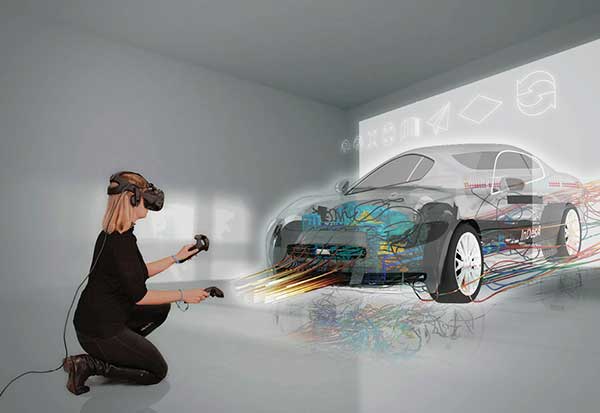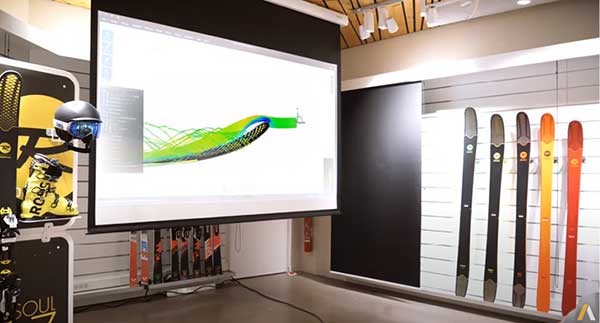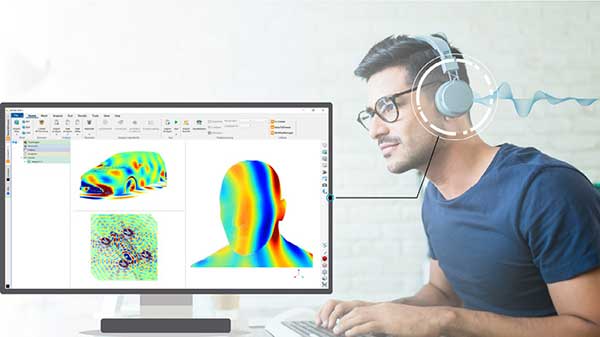Democratizing Simulation Insights
A focus on post-processing capabilities and creative use of emerging technologies takes the democratization of simulation to the next level, boosting accessibility of analysis-driven insights.

Simcenter STAR-CCM+ employs virtual reality to better understand flow patterns, which help to deliver critical performance insights to non-experts. Image courtesy of Siemens Digital Software Industries.
Latest News
February 15, 2021
When designing a product such as a high-precision ski, it’s often hard-core enthusiasts and non-engineering team members who have the most astute insights into what tweaks can recalibrate performance.
At Rossignol, simulation is emerging as the unlikely lingua franca to drive design decisions in near real time. An extended team of engineers and designers use Ansys Discovery to glean insights from simulations far earlier in the design process while making the findings available to non-experts in business roles.
Simulations are also instrumental in soliciting customer feedback to assess and drive design changes. The result: Simulation has become the shared language for exploring product performance and vastly accelerating Rossignol’s time-to-delivery process from idea to prototype to release of the season’s hottest ski.
“We can immediately see how parties are going to react [to changes] and we don’t have to wait a week to make a prototype,” says Pierre Vauge, R&D project manager at Rossignol. “Within an hour, we can see five or six different parts and make a decision. With normal software, we can’t do that.”

The insights that Ansys Discovery produces create a visual way to demonstrate the benefits of the Rossignol technology to those who lack formal training in simulation or any background in physics model interpretation, he adds.
Companies are turning to simulation far earlier and more frequently as they try to work out kinks in a virtual world when it’s easier to make design changes and far less expensive than building physical prototypes.
Making simulation tools easier to deploy has been one of the hallmarks of democratization, and intended to allow non-Ph.D.s and engineers not fluent in simulation tools to use the software without having to rely on experts and simulation specialists.
Moving forward, vendors are building all kinds of new post-processing functionality, from visualization tools to creative use of virtual reality and audio capabilities, into their software to democratize insights from simulation so a larger audience can use them to make smarter product-related decisions.
“There is a wealth of knowledge and insights that are hidden inside of simulation models—in the past, those insights were restricted to people who are experts, who know how to look at and interpret results, and make recommendations to someone else,” says Ravi Shankar, director for Simcenter product marketing at Siemens Digital Software Industries. “Because of the imperatives digitization brings forth and because companies need to move quicker, insights need to be propagated throughout the enterprise so others in the organization can experience what simulation is revealing.”
Immersive Experience
One way to surface simulation insights is to make the results more immersive using newer technologies such as virtual reality (VR). Siemens has embraced this strategy with a variety of offerings, including the idea of collaborative VR with Simcenter STAR-CCM+. With this capability, a less experienced simulation and VR user can tether themselves to someone with more experience and simultaneously navigate the simulation model results.
With collaborative VR, team members can confirm the correct assemblies and parts are in place before they build a full mesh; review and refine mesh strategies together to save time; and navigate a structure such as a large ship to understand how upstream airflow disruptions can impact what passengers experience at deck level.
“One person guiding and another following is a great way to experience the results of simulation,” Shankar explains. “The insights are so much deeper than if you were just looking at some charts.”
Screen Play is another Simcenter STAR-CCM+ capability, which delivers advanced animation capabilities to help users craft simulation insights into a compelling narrative—for instance, to showcase the transient process of particle separation in a cyclone or to communicate the placement and flow of AC units in a room to optimize temperature.
In Simcenter 3D 3.0, a new post-processing capability lets engineers explore acoustic simulation results with actual sounds, instead of frequency plots and charts, so they can understand the impact of changes on designs.
“Think about it as taking things away from an engineering-centric perception to a perception that everyone knows and understands because it’s what you experience,” he says.
Making simulation accessible to anyone, anywhere, on any device is a key focus of MSC Software. Now a division of Hexagon AB, the company is connecting its simulation software to its manufacturing and quality engineering software as part of a broader strategy around manufacturing intelligence.
For instance, the company has embedded a costing model into its additive manufacturing simulation tools; engineers can explore how to optimize part positioning and the build strategy to minimize warpage and improve quality, while a manager could leverage the same simulation results to get insight into which printer to use or which materials lead to less expensive output.

By allowing the generation of audio files, Actran, acoustic simulation software from Hexagon, helps non-experts accurately hear their products’ sound and make relevant decisions to improve it.
Image courtesy of MSC Software.
“Knowing which combination of printer and material will lead to less cost is something that can come from simulation and it’s interesting to the person doing the quotation—not just the engineer printing the part,” says Roger Assaker, MSC Software’s CEO. “It’s the same simulation, but the post-processing is very different. You’re translating simulation into actionable data that people can make decisions on.”
To provide more engineering insights, MSC Software has created integrations and workflows to leverage simulation results in the tools manufacturing engineers and managers know how to read. One such integration is between Simufact, MSC’s tool for simulating manufacturing processes, and eMMA, software that handles metrology data across the product lifecycle for industries like automotive stamping and car body assembly.
The integration lets a quality assurance engineer use what they are comfortable with—in this case eMMA, to look at tolerances, but instead of the results coming from a physical metrology device, they come from simulation software.
“It lets the trial-and-error process be done in simulation instead of in the design stage when you have the first prototype,” he explains.
Moving forward, MSC Software is also working to integrate augmented reality/VR capabilities to make simulation results more life-like and interactive as well as serving up simulation results in an app-style format so they can be accessed from anywhere on a mobile device, Assaker says.
At Ansys, democratizing insights is based on allowing engineers to interact with findings in normal engineering terms, not just numerical analysis, and in being able to visually represent and manipulate 3D data on demand.
Ansys Discovery software enables stock-like tickers that provide easy-to-read interpretations of key design metrics such as safety factors or the likely breakage of a particular material, and the values are updated with every design change.
“We call these engineering insights,” says Mark Hindsbo, general manager and vice president of Ansys’ design business unit. “You get away from specialized language … and heighten an abstraction layer into engineering qualities that everyone in the domain is familiar with.”
COMSOL’s strategy for democratizing simulation data is centered around Application Builder, COMSOL Server, and COMSOL Compiler. The platform allows simulation specialists to deliver insights to domain experts and non-simulation users in a language that’s familiar.
For example, a domain expert in battery manufacturing knows exactly what’s important to understand about thermal management as does someone building optical products in terms of tolerances or part placement. What they don’t know is how to create and refine models, run tests or configure complex simulation software to deliver the desired insights.

COMSOL App Builder enables internal specialists to create highly customized modeling apps that domain experts can easily manage and run on their own, streamlines the workflow, allows feedback from collaborators that don’t have a COMSOL Multiphysics license, and ensures simulation insights are pervasive throughout the entire design process without requiring everyone to understand simulation. The COMSOL Compiler is a tool for taking compiling a stand-alone app that then can be sent (even sold) to a customer, or used by student or some other contact. They recipient does not need a COMSOL license.
“Non-COMSOL users speak a different language than us,” explains Bjorn Sjodin, vice president of product management at COMSOL. “We can’t give them what they want, but users working with our tools and technologies can get the software to produce an output in the way they want it rather than the abstract representations we would create.”
COMSOL has also steadily added new capabilities for easily sharing simulation. The Multiphysics software enables users to export 3D plots as gITF files for sharing in a variety of web-based graphics viewers, including Facebook posts, and to easily output reports in PowerPoint, which promotes self-service and encourages widespread distribution of insights.
Support for the cloud and its 3DEXPERIENCE platform are crucial to Dassault Systèmes’ strategy to move simulation to a regular part of all product-related workflows.
The 3DEXPERIENCE platform makes simulation data easily accessible to all program stakeholders on the platform while the cloud enables collaboration, according to Christian Whiting, senior director of structural simulation for Abaqus on the 3DEXPERIENCE platform. The tools help a range of users understand results by serving them up in key performance indicators (KPIs) that are relevant for their particular role.
Other capabilities that make it easier for Dassault users to consume simulation data include a compare results tool, which allows users to easily do a side-by-side review of results from different design alternatives and a performance trade-off capability in 3DEXPERIENCE, which helps users compare multiple simulations in a dashboard via a web browser against a customized set of KPIs.
“This enables teams to share performance trade-off analysis with customers and partners and use simulation as an insight for business decisions,” explains Delphine Genouvrier, portfolio manager on the SIMULIA R&D team.
AI and the Road Ahead
Beyond KPIs, dashboards and immersive post-processing capabilities, artificial intelligence (AI) will play a role in democratizing simulation software and key insights. On one hand, AI will enable a paradigm shift where CAE is used for design of experiments (DOEs), and helps feed models that allow for faster run times, improved productivity and better optimization of products.
AI can help generate synthetic data with characteristics similar to physical data from the original dataset when there is too little available data and, conversely, be used to develop reduced order models (ROMs) of finite element analyses when there is too much data to churn through.
AI can also be used to generate automated recommendations for how to configure a system, including selecting the optimal model.
“Most engineers know turbulence, but they don’t know which numerical model will provide the best answers,” says Ansys’ Hindsbo. “AI can drive the software to configure the best set up and drive more accurate results and insights.”
Though the efforts to make simulation insights more accessible are important, experts caution that democratization efforts should have some limits.
“If you are responsible for a department that has to design an aircraft or an engine, you wouldn’t open the door to make design decisions to someone that doesn’t understand the physics of the product,” says Charles Hirsch, president of NUMECA. “You can’t think of the concept of democratization as allowing anyone without knowledge of the physics to do the design work on an engine. That is not possible.”
Sources: Press materials received from the company and additional information gleaned from the company’s website.
More Ansys Coverage
More COMSOL Coverage
More Dassault Systemes Coverage

More Hexagon Manufacturing Intelligence Coverage
More Hexagon MSC Software Coverage
Subscribe to our FREE magazine, FREE email newsletters or both!
Latest News
About the Author
Beth Stackpole is a contributing editor to Digital Engineering. Send e-mail about this article to [email protected].
Follow DERelated Topics







